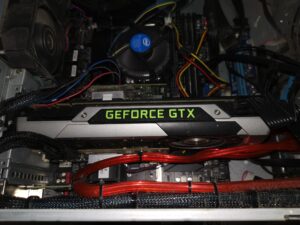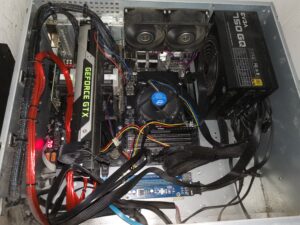The time has come yet again, to reduce my rack footprint. For the last 5 years or so, this blog has been hosted on a small HP MicroServer Gen8, as at the time I needed a new host machine, and for some reason they were going by their thousands for rock-bottom cash. That machine has faithfully worked 24/7, without many gripes, but it’s time to concentrate things down to requiring less physical hardware.
What’s enabled me to sort this out, is performing a hardware rebuild on my main file server, which has for years been a Heath-Robinson affair.

Well, the file server got ANOTHER upgrade, quite quickly. The motherboard was replaced again, this time with a new board, new Corsair RAM & a new Intel i7-9700F 8-Core CPU. As this server also runs video transcoding services, the tiny GPU got pulled & replaced with a spare nVidia GTX980 I had just for that task. My LSI RAID cards are still used as HBAs, just as JBOD, since Linux is running the main disk array via mdadm.

Once this upgrade was completed, with space for resource expansion – the motherboard supports up to 128GB RAM, at the moment there’s 32GB in there due to the eye-watering cost of RAM at the present time – there was scope for running some Virtualisation for other services.
Still running OpenMediaVault, based around Debian 10, I installed the Kernel KVM modules & QEMU, along with Cockpit for control. Going this route was dictated by VirtualBox not being directly supported in Debian 10, for reasons I don’t know.
Once all this was installed, and a network bridge set up for the VMs through a spare network interface, I brought up a pair of Debian 10 servers – one for PiHole which had up until this point been running on a spare Raspberry Pi for the last 6 or so years (I think the SD card is totally shot at this point!), and one for my web App server.
At the moment, all the VMs are running from the main RAID6 spinning rust array, which is a little slow, but the next planned upgrade is to move the VM subsystem to it’s own RAID10 array of disks, hopefully speeding things up – there are just enough SATA ports left on the motherboard to accommodate 6 more drives, and with both 5.25″ disk bays being available for caddies, this should be a simple fix.
As a result, I’m down to a single server powering my entire online domain, and a reduction in power usage!
